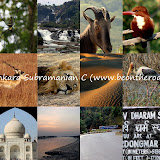
The Great Himalayan National Park is situated in the Seraj Tehsil of Kullu district and is about 50 km from Kullu. The Great Himalayan National Park (754 sq km) consists of the watersheds of the Jiwa, Sainj and the Tirthan rivers, all tributaries of the Beas. It is naturally protected on its eastern boundary by the Great Himalayan range, and on the southern and northern boundaries by areas under permanent snow or by impassable bridges. The boundaries of the park are contiguous with the Pin Valley National Park in the Trans-Himalaya, the Rupi Bhaba Wildlife Sanctuary in the Sutlej watershed and the Kanawar Wildlife Sanctuary.

After a great bird watching experience at the Pong Dam Wetlands near Nagrota Surian, I took winding mountain roads through Palampur and Mandi to reach Sai Ropa, the small village where the boundary of the Great Himalayan National Park begins. I had booked my accommodation here at the Sai Ropa forest rest house. It was close to 5 pm in the evening by the time I checked into my forest room. It is here at the Sai Ropa range office that one can get entry tickets for the park. The entire Sai Ropa forest complex includes a Forest rest house and 4 dormitories. There was 2 hours to darkness and I aimed to utilize this time to explore the bio diversity trails near the Sai Ropa forest rest house, which has trees and medicinal plant species that have been transplanted from the park. I had worked up quite a sweat before darkness set in. The temperature started dipping rapidly and I managed a good sleep partly due to the exhaustion from a long drive and partly due to the effective mobile room heater in the forest rest house.
I stayed here at the Sai Ropa forest rest house for 3 days and each day, I went on 2 day treks to explore different parts of the Great Himalayan national park (parts of the Sainj Valley Trek and the Sainj-Tirthan valley trek). So me and my forest guide would leave in the early hours of the morning and return late hours in the evening. We would follow the Tirthan river to reach the main entry point of the Great Himalayan National Park and each day we would ascent to heights of about 3,000m where the air gets thinner and every slow step turns into a gasp.

Altitude within the park range from 1,700-5,800m. This vast range of altitude supports forests that vary from sub tropical to alpine. Among the larger mammals that one is likely to encounter in the park are the ghoral in the lower forests, the Himalayan Tahr in the higher forests, and the bharal or blue sheep above the tree line. These are prey for the leopards (in the forest zone) and snow leopards (above the tree-line). The park is also home to large populations of the Himalayan black bear (found in the forests) and the Asiatic brown bear (found primarily in the alpine meadows). The most famous of Great Himalayan National park’s birds, the monal, koklass, and the western tragopan, all pheasants, are found in the upper forest zone.

During my 2 day treks through the Sainj and the Tirthan valleys, I wasn’t lucky in spotting the resident wildlife here with the exception of a monal pheasant, an oriental white-eye, a yellow magpie robin and other sub-Himalayan birds. The reason I guess was that during the winter of 2009, the snow line crept up on lack of enough snowfall and thereby taking the wildlife higher along with it. But, I definitely appreciated the beauty that this terrain had to offer. The snow clad peaks, the thin air, the alpine meadows all made for a great experience. Now that I have been here and seen what this place has to offer, I am bound to return with all my mountain trekking gear and go on the long trek from the Great Himalayan National Park to the Pin Valley National Park and soak in the sights of the Himalayan glaciers, the snow clad peaks and the Himalayan wildlife.
To see India through the eyes of a motorcyclist’s lens, visit the album below.
 |
| my solo all-india motorcycle journey |
No comments:
Post a Comment